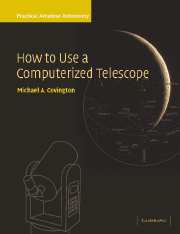Book contents
- Frontmatter
- Contents
- Preface
- Part I Telescopes in general
- 1 Welcome to amateur astronomy!
- 2 How the sky moves
- 3 How telescopes track the stars
- 4 Using equatorial mounts and wedges
- 5 Telescope optics
- 6 Eyepieces and optical accessories
- 7 Astrophotography
- 8 Troubleshooting
- Part II Three classic telescopes
- Index
8 - Troubleshooting
Published online by Cambridge University Press: 10 February 2010
- Frontmatter
- Contents
- Preface
- Part I Telescopes in general
- 1 Welcome to amateur astronomy!
- 2 How the sky moves
- 3 How telescopes track the stars
- 4 Using equatorial mounts and wedges
- 5 Telescope optics
- 6 Eyepieces and optical accessories
- 7 Astrophotography
- 8 Troubleshooting
- Part II Three classic telescopes
- Index
Summary
This chapter gives quick solutions to a number of common problems that are likely to puzzle a new telescope owner. This list is far from complete. For more information, see your instruction book, as well as Chapters 10–12 and the websites mentioned there.
Electrical and computer problems
Telescope is electrically dead
Check all fuses. On the LX200, there is a fuse inside the connector panel as well as in the power cable.
Check keypad and declination cables too. If deprived of any of its necessary connections, the computer will not initialize normally and the telescope may seem to be electrically dead.
Check for a coaxial power connector that is the wrong size. The diameter of the central pin is smaller on Celestron than on Meade telescopes. The Meade connector fits Celestron telescopes but gives a loose connection.
Computer hangs or resets at random moments
This is often caused by a loose connection somewhere in the power system; inadequate battery voltage; or electrical noise on the power line, such as poor filtering of an AC-operated power supply.
If using internal batteries, check the battery contacts and try using an external power supply. Rechargeable lead-acid batteries are the gold standard for power supplies; they produce very clean, well regulated DC.
Make sure coaxial DC connectors are the right type and are firmly plugged in. On the NexStar 5 and some others, the central pin of the socket consists of two tines that you can spread apart with a screwdriver to get a better connection.
- Type
- Chapter
- Information
- How to Use a Computerized TelescopePractical Amateur Astronomy Volume 1, pp. 122 - 130Publisher: Cambridge University PressPrint publication year: 2002

